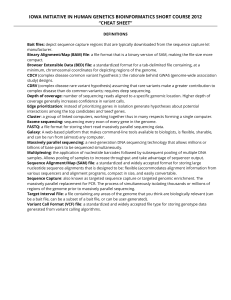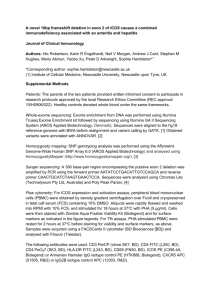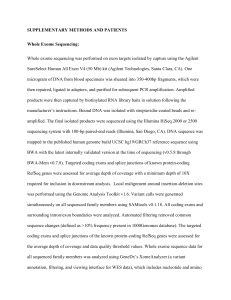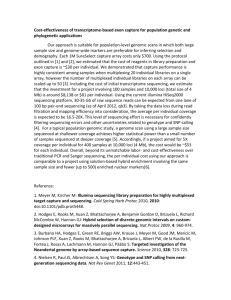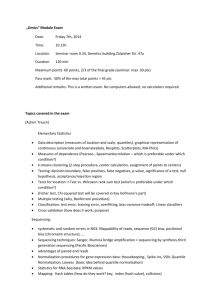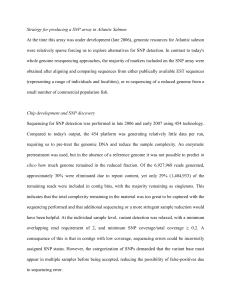Next Generation Sequencing - Benefits for Patients
advertisement
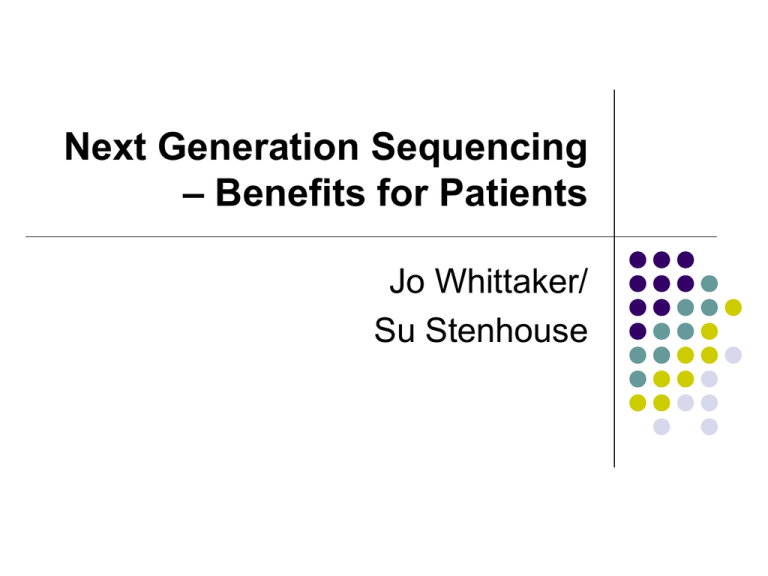
Next Generation Sequencing – Benefits for Patients Jo Whittaker/ Su Stenhouse NGS – Benefits for Patients What is Next Generation Sequencing? What are the benefits for patients? How will the benefits be realised? What is Next Generation Sequencing? Massively parallel sequencing Genomic DNA ACTGTAATGGCA Whole genome sequence – consensus of aligned reads Fragmented library of small pieces all sequenced at same time A__GT___G__A _T___G__A GT___G__A__ A__GT___G A__GT___G__A Individual reads aligned to reference sequence What is Next Generation Sequencing? Massive sequence output possible Terabytes of data (1,000,000,000,000) Highly scalable Lower output machine; fewer samples per run; faster results exomes ‘targeted’ regions (eg disease specific ‘set’ of genes) High throughput machine multiplex samples; target specific region to screen many samples for particular variant whole genome sequence What is Next Generation Sequencing? Evolving technology Illumina HiSeq 2000 Life Technologies SOLiD 4 Ion Torrent PGM Illumina MiSeq Pacific Biosciences RS Roche 454 GS FLX Roche GS Junior and then there is the bioinformatics What are the benefits for patients? Would you like a copy of the results? What are the benefits to patients? Widely applicable technology variants in individual’s DNA vs ‘reference’ sequence may identify new disease genes – high diagnostic yield increased efficacy of treatments reduced deleterious/no response to treatments preventative treatments differentiation of disease subtypes How will the benefits be realised? Marcel Nelen & Joris Veltman, Nijmegen …. we think whole-genome- or exome-based approaches are currently most suited for diagnostic implementation in genetically heterogeneous diseases, initially to complement and later to replace Sanger sequencing, qPCR and genomic microarrays. Establishing the pathogenicity of individual genetic variants remains a daunting task, requiring novel bioinformatic tools and high-throughput functional approaches………. Pharmacogenomics. 2012 Apr;13(5):511-4. Genome and exome sequencing in the clinic: unbiased genomic approaches with a high diagnostic yield. David Goldstein & colleagues Duke University Highlighted two challenges in particular First, in our experience, laboratory-based functional analysis is an important part of the evaluation, and it remains unclear how this would be incorporated into routine clinical application of NGS…… Second, this work required substantial manual interrogation of both sequence data and candidate genes. Although variant calling procedures are continually improved and there are likely to be routines developed to simplify the process of candidate identification, it seems likely that for the foreseeable future, some level of expert judgement will continue to be required to identify causal mutations from sequence data, which will contribute to the cost and time of this type of diagnostics. JMG Online First, published on May 11, 2012 as 10.1136/jmedgenet-2012-100819 Clinical application of exome sequencing in undiagnosed genetic conditions Anna C Need, Vandana Shashi, Yuki Hitomi, Kelly Schoch, Kevin V Shianna, Marie T McDonald, Miriam H Meisler, David B Goldstein What are the benefits for patients? Sharon and Ozzy both had a ‘genome test’ – looked at genes predisposing to serious illness Ozzy’s results – ‘perfect’ Sharon’s results – already knew she was genetically predisposed to colon cancer (and has been affected) She also carries a gene mutation predisposing to breast cancer She opted for a bilateral mastectomy –at the moment cannot accurately predict if / when she would develop breast cancer How will the benefits be realised? We want to set the test up - there are only 22 other labs doing it We’ve got our own sequencer It’s a secret…… Genetics is different We don’t need to work with ‘x’ology How will the benefits be realised? Select new ‘best friends’ Pathologist Obstetrician Nephrologist Bioinformaticist Neonatologist Endocrinologist Cardiologist UKGTN Lab Oncologist Develop specialist knowledge – define your service’s unique strengths How will the benefits be realised? Collaboration Networking Developing standardised protocols Using standardised locus specification and variant nomenclature Quality assuring sequencing processes Quality assuring data analysis processes Phenotype & genotype data sharing Providing equitable access to the right test for the patient What are the benefits for patients? Higher diagnostic yield and more timely diagnosis Research describing the course of a disease or development of a disorder may allow it to be more effectively treated or prevented What are the benefits for patients? Hopefully, more choices about how to live with or manage their disorder


